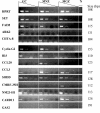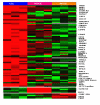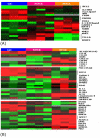Distinct gene expression profiles in different B-cell compartments in human peripheral lymphoid organs
- PMID: 15369600
- PMCID: PMC535350
- DOI: 10.1186/1471-2172-5-20
Distinct gene expression profiles in different B-cell compartments in human peripheral lymphoid organs
Abstract
Background: There are three major B-cell compartments in peripheral lymphoid organs: the germinal center (GC), the mantle zone (MNZ) and the marginal zone (MGZ). Unique sets of B-cells reside in these compartments, and they have specific functional roles in humoral immune response. MNZ B cells are naive cells in a quiescent state and may participate in GC reactions upon proper stimulation. The adult splenic MGZ contains mostly memory B cells and is also known to provide a rapid response to particulate antigens. The GC B-cells proliferate rapidly and undergo selection and affinity maturation. The B-cell maturational process is accompanied by changes in the expression of cell-surface and intracellular proteins and requires signals from the specialized microenvironments.
Results: We performed laser microdissection of the three compartments for gene expression profiling by cDNA microarray. The transcriptional program of the GC was dominated by upregulation of genes associated with proliferation and DNA repair or recombination. The MNZ and MGZ showed increased expression of genes promoting cellular quiescence. The three compartments also revealed distinct repertoires of apoptosis-associated genes, chemokines and chemokine receptors. The MNZ and GC showed upregulation of CCL20 and CCL18 respectively. The MGZ was characterized by high expression of many chemokines genes e.g. CXCL12, CCL3, CCL14 and IFN-associated genes, consistent with its role in rapid response to infections. A stromal signature was identified including genes associated with macrophages or with synthesis of extracellular matrix and genes that influenced lymphocyte migration and survival. Differentially expressed genes that did not belong to the above categories include the well characterized BCL6 and CD10 and many others whose function is not known.
Conclusions: Transcriptional profiling of B-cell compartments has identified groups of genes involved in critical molecular and cellular events that affect proliferation, survival migration, and differentiation of the cells. The gene expression study of normal B-cell compartments may additionally contribute to our understanding of the molecular abnormalities of the corresponding lymphoid tumors.
Figures









Similar articles
-
Differential expression of cytokines, chemokines and their receptors in follicular lymphoma and reactive follicular hyperplasia: assessment by complementary DNA microarray.Oncol Rep. 2005 May;13(5):819-24. Oncol Rep. 2005. PMID: 15809744
-
Expression of chemokine receptors, CXCR4 and CXCR5, and chemokines, BLC and SDF-1, in the eyes of patients with primary intraocular lymphoma.Ophthalmology. 2003 Feb;110(2):421-6. doi: 10.1016/S0161-6420(02)01737-2. Ophthalmology. 2003. PMID: 12578791
-
Inflammation and ectopic lymphoid structures in rheumatoid arthritis synovial tissues dissected by genomics technology: identification of the interleukin-7 signaling pathway in tissues with lymphoid neogenesis.Arthritis Rheum. 2007 Aug;56(8):2492-502. doi: 10.1002/art.22748. Arthritis Rheum. 2007. PMID: 17665400
-
Chemokine-mediated control of T cell traffic in lymphoid and peripheral tissues.Mol Immunol. 2005 May;42(7):799-809. doi: 10.1016/j.molimm.2004.06.040. Epub 2004 Nov 23. Mol Immunol. 2005. PMID: 15829268 Review.
-
Lymphoid stroma in the initiation and control of immune responses.Immunol Rev. 2008 Aug;224:284-94. doi: 10.1111/j.1600-065X.2008.00657.x. Immunol Rev. 2008. PMID: 18759934 Review.
Cited by
-
Use of nCounter mRNA profiling to identify at-arrival gene expression patterns for predicting bovine respiratory disease in beef cattle.BMC Vet Res. 2022 Feb 23;18(1):77. doi: 10.1186/s12917-022-03178-8. BMC Vet Res. 2022. PMID: 35197051 Free PMC article.
-
B-cell capacity for differentiation changes with age.Aging Cell. 2021 Apr;20(4):e13341. doi: 10.1111/acel.13341. Epub 2021 Mar 12. Aging Cell. 2021. PMID: 33711204 Free PMC article.
-
Fas apoptosis inhibitory molecule expression in B cells is regulated through IRF4 in a feed-forward mechanism.J Immunol. 2009 Nov 1;183(9):5575-81. doi: 10.4049/jimmunol.0901988. J Immunol. 2009. PMID: 19843941 Free PMC article.
-
Hairy cell leukemia: a specific 17-gene expression signature points to new targets for therapy.J Cancer Res Clin Oncol. 2022 Aug;148(8):2013-2022. doi: 10.1007/s00432-022-04010-4. Epub 2022 Apr 27. J Cancer Res Clin Oncol. 2022. PMID: 35476232 Free PMC article.
-
Digitaldlsorter: Deep-Learning on scRNA-Seq to Deconvolute Gene Expression Data.Front Genet. 2019 Oct 25;10:978. doi: 10.3389/fgene.2019.00978. eCollection 2019. Front Genet. 2019. PMID: 31708961 Free PMC article.
References
-
- Butcher EC, Picker LJ. Lymphocyte homing and homeostasis. Science. 1996;272:60–6. - PubMed
-
- Rolink A, Nutt S, Busslinger M, ten Boekel E, Seidl T, Andersson J, Melchers F. Differentiation, dedifferentiation, and redifferentiation of B-lineage lymphocytes: roles of the surrogate light chain and the Pax5 gene. Cold Spring Harb Symp Quant Biol. 1999;64:21–5. doi: 10.1101/sqb.1999.64.21. - DOI - PubMed
Publication types
MeSH terms
Substances
Grants and funding
LinkOut - more resources
Full Text Sources
Miscellaneous

